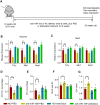Colon specific delivery of miR-155 inhibitor alleviates estrogen deficiency related phenotype via microbiota remodeling
- PMID: 35938574
- PMCID: PMC9364735
- DOI: 10.1080/10717544.2022.2108163
Colon specific delivery of miR-155 inhibitor alleviates estrogen deficiency related phenotype via microbiota remodeling
Abstract
Compelling data have indicated menopause-associated increase in cardiovascular disease in women, while the underlying mechanisms remain largely unknown. It is established that changes of intestinal microbiota affect cardiovascular function in the context of metabolic syndrome. We here aimed to explore the possible link between host intestinal function, microbiota, and cardiac function in the ovariectomy (OVX) mouse model. Mice were ovariectomized to induce estrogen-related metabolic syndrome and cardiovascular defect. Microbiota was analyzed by 16s rRNA sequencing. miRNA and mRNA candidates expression were tested by qPCR. Cardiac function was examined by echocardiography. Colon specific delivery of miRNA candidates was achieved by oral gavage of Eudragit S100 functionalized microspheres. In comparison with the sham-operated group, OVX mice showed compromised cardiac function, together with activated inflammation in the visceral adipose tissue and heart. Lactobacillus abundance was significantly decreased in the gut of OVX mice. Meanwhile, miR-155 was mostly upregulated in the intestinal epithelium and thus the feces over other candidates, which in turn decreased Lactobacillus abundance in the intestine when endocytosed. Oral delivery of miR-155 antagonist restored the protective microbiota and thus protected the cardiac function in the OVX mice. This study has established a possible regulatory axis of intestinal miRNAs-microbiota-estrogen deficiency related phenotype in the OVX model. Colon specific delivery of therapeutic miRNAs would possibly restore the microbiota toward protective phenotype in the context of metabolic syndrome.
Keywords: Microbiota; cardiac function; colon specific drug delivery; metabolic syndrome; miRNAs.
Conflict of interest statement
No potential conflict of interest was reported by the authors.
Figures







Similar articles
-
Effect of Curcumin on the Diversity of Gut Microbiota in Ovariectomized Rats.Nutrients. 2017 Oct 19;9(10):1146. doi: 10.3390/nu9101146. Nutrients. 2017. PMID: 29048369 Free PMC article.
-
Kefir Peptides Prevent Estrogen Deficiency-Induced Bone Loss and Modulate the Structure of the Gut Microbiota in Ovariectomized Mice.Nutrients. 2020 Nov 9;12(11):3432. doi: 10.3390/nu12113432. Nutrients. 2020. PMID: 33182364 Free PMC article.
-
An emerging role of Prevotella histicola on estrogen deficiency-induced bone loss through the gut microbiota-bone axis in postmenopausal women and in ovariectomized mice.Am J Clin Nutr. 2021 Oct 4;114(4):1304-1313. doi: 10.1093/ajcn/nqab194. Am J Clin Nutr. 2021. PMID: 34113963
-
Berberine Ameliorates Periodontal Bone Loss by Regulating Gut Microbiota.J Dent Res. 2019 Jan;98(1):107-116. doi: 10.1177/0022034518797275. Epub 2018 Sep 10. J Dent Res. 2019. PMID: 30199654
-
Chitosan alleviated menopausal symptoms and modulated the gut microbiota in estrogen-deficient rats.Eur J Nutr. 2021 Jun;60(4):1907-1919. doi: 10.1007/s00394-020-02382-2. Epub 2020 Sep 10. Eur J Nutr. 2021. PMID: 32910260
Cited by
-
The correlation between gut microbiome and atrial fibrillation: pathophysiology and therapeutic perspectives.Mil Med Res. 2023 Nov 7;10(1):51. doi: 10.1186/s40779-023-00489-1. Mil Med Res. 2023. PMID: 37936201 Free PMC article. Review.
-
Gut-heart axis: cardiac remodeling and heart failure in the context of inflammatory bowel disease and dysbiosis.Am J Physiol Gastrointest Liver Physiol. 2025 Jul 1;329(1):G122-G137. doi: 10.1152/ajpgi.00016.2025. Epub 2025 May 19. Am J Physiol Gastrointest Liver Physiol. 2025. PMID: 40387516 Free PMC article. Review.
-
Rocket-miR, a translational launchpad for miRNA-based antimicrobial drug development.mSystems. 2023 Dec 21;8(6):e0065323. doi: 10.1128/msystems.00653-23. Epub 2023 Nov 17. mSystems. 2023. PMID: 37975659 Free PMC article.
-
Host-dependent alteration of the gut microbiota: the role of luminal microRNAs.Microbiome Res Rep. 2025 Feb 22;4(1):15. doi: 10.20517/mrr.2024.46. eCollection 2025. Microbiome Res Rep. 2025. PMID: 40207285 Free PMC article. Review.
References
-
- Aron-Wisnewsky J, Warmbrunn MV, Nieuwdorp M, Clément K. (2021). Metabolism and metabolic disorders and the microbiome: the intestinal microbiota associated with obesity, lipid metabolism, and metabolic health-pathophysiology and therapeutic strategies. Gastroenterology 160:573–99. - PubMed
-
- Barros RP, Gustafsson JA. (2011). Estrogen receptors and the metabolic network. Cell Metab 14:289–99. - PubMed
MeSH terms
Substances
LinkOut - more resources
Full Text Sources
Medical
Molecular Biology Databases
